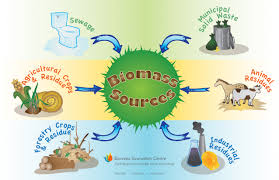Biomass is an abundant renewable resource in developing countries. As we know, biomass is nothing but solar energy stored in a chemical form in plant and animal materials. It is a truly rich energy resource endowed with a significant potential to meet the energy end-use requirements of millions of people worldwide. It provides not only food and energy, but also raw material for cloth, paper, medicines, chemicals, buildings, etc. Today, biomass derived fuels are used to heat homes, run cars and buses and even computers. Hardly any part of biomass worth wasting.
Nature has blessed us with these resources in ample measure. Biomass use energy also contributes to indoor air pollution and associated negative health impacts. However, if the production and conversion of biomass is modernised, it has the potential to provide a much higher level of energy services in developing countries, in environmentally friendly ways. Biomass technologies use renewable biomass resources to produce an array of energy related products including electricity, liquid, solid, and gaseous fuels, heat, chemicals and other materials.
The term biomass means any plant derived organic matter available on a renewable basis, including dedicated energy crops and trees, wood waste and residues, aquatic plants, and other waste materials. There are three ways to use biomass, burnt to produce heat and electricity, changed to a gas like fuel such as methane, Biomass is considered to be one of the key renewable resources of the future at both small and large scale levels. It already supplies 14% of the world’s primary energy consumption. For three quarters of the world’s population in developing countries, biomass is the most important source of energy. It has been called as “the poor man’s oil” because of its direct use by combustion for domestic cooking and heating.
The three main categories of raw feedstock materials for biomass technologies are:
- Agricultural waste such as crop residues of cereals, pulses, oil seeds and fibres, animal wastes, etc.
- Agro-industrial waste such as dust, wood chips, groundnut shells, rice husk, coconut shell, jute mill waste etc.
- Plantation crops like coffee husk, tea waste, sugarcane leaves etc.
Plants are the most common resources of biomass. Biomass can also be produced by so-called short rotation plantation of trees and other plants like grasses. Growing biomass is a labour intensive activity and it can create jobs in rural areas.
A number of biomass energy technologies exist worldwide. The technologies are based on direct combustion, thermo-chemical processing and biological processing. Direct combustion is the commonest and the simplest way of extracting energy from biomass resources. A significant population of the developing countries still burns cow dung cakes, coal or plant residues in open stoves to meet their cooking and heating needs. Unfortunately this simple method is also quite inefficient. Now thermo-chemical processing, in this processing, pyrolysis, gasification and liquefaction are included. Charcoal production takes place through pyrolysis. I t can be produced from nearly any kind of plant derived biomass material. The production of charcoal spans a wide range of technologies.
In biological processing, fermentation and anaerobic digestion are biological processes that can be used to derive useful energy from biomass. Fermentation is a unique feature of biomass energy, in which it can be converted directly into liquid bio fuels such as ethanol and bio diesel. Bio diesel is being used as a diesel addictive to reduce vehicle emissions or in its pure form to run a vehicle. Bio gas is a colourless, tasteless, odourless, non toxic, inflammable gas, produced by the decomposition of organic waste and biomass such as animal, human and plant wastes, weeds, grasses, vines, leaves, aquatic plants and crop residues etc. It is produced in the absence of air, in a process in which the organic material is converted into methane and carbon di oxide.
The one essential requirement in producing biogas is an airtight container. The air tight container used for the biogas production under artificial condition is known as digester or reactor.
There are some of the key initiatives of Indian Biomass Production Programme such as, established potential of 3,500 MW of power through biogas based co generation in sugar mills, biomass power generation from surplus agricultural residue, large number of installations for providing power to small scale industries and for electrification of a village or group of villages, new programme on advanced biomass gasification for development and application of advanced technologies, such as, Biomass Integrated Gasification-cum-Gas Turbine Combined Cycle technology.
Gosoba is one of the several important islands of Sunderbans, a place located around 135 km from the main city of Kolkata in West Bengal. It has no grid connection until 1997. There a 5500 kW capacity biomass gasifier system was put up for the electrification of 5 villages, having collective population of about 10,000 people. Gosaba is now known as a energy island due to path breaking initiatives taken by West Bengal Renewable Energy Development Agency (WBREDA) and at present, domestic, commercial and industrial users are using the electric power supply from these gasifiers for a variety of end use applications.
We hope, through this article, you have acquired some insights into the usefulness of biomass as a sustainable energy resource.




Leave a Reply